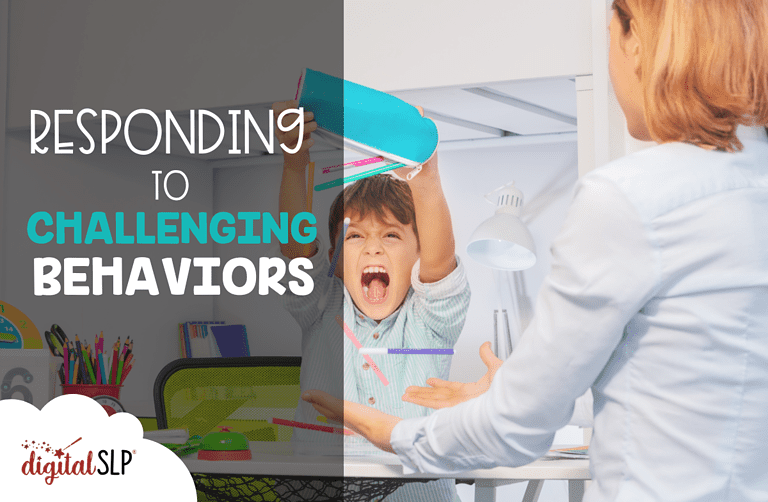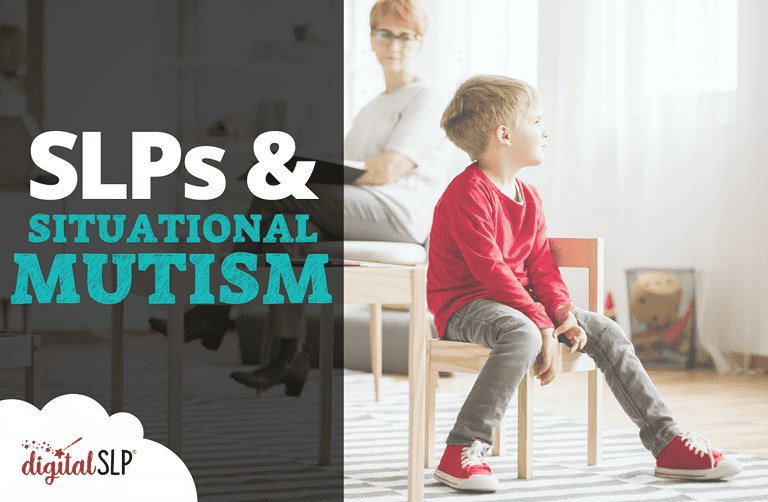Today’s blog post is about responding to challenging behaviors in our speech therapy sessions. I hope all of you will come away with some relevant nuggets for your particular context!
We’ve all been there. We go into a speech session feeling confident, and . . . it’s a catastrophe. Maybe our student tries to run away, or they throw materials across the room, or they even scream at us. No matter the specifics, the end result is the same: we feel like failures.
We’re in This Together
More than anything, I want to emphasize the first sentence I wrote: We’ve all been there! Every single SLP has had a disastrous session (if you haven’t, please reach out and share your secrets!). You’re not alone, and you’re not a bad SLP.
Responding (to Challenging Behaviors), Not Reacting
The second idea I want to underscore is from the title of this post: the concept of responding, not reacting. When we respond to a situation, we act from a calm-ish place. When we react to a situation, our actions are less thoughtful.
Often, the difference between a response and a reaction comes down to which part of our nervous system is in charge at a given moment. If our parasympathetic (a.k.a. “rest and digest”) nervous system is running the show, we can usually respond. If our sympathetic (a.k.a. “fight or flight”) nervous system is taking over, we tend to be more reactive.
So, one of the best tools we have for dealing with difficult behaviors is the ability to regulate our own nervous system response! Here are some strategies for quickly activating the parasympathetic nervous system:
- Breathe slowly and deeply
- Gently put your hand over your heart (or wherever feels comfortable)
- Visualize yourself in a calm place
- Touch your upper lip (really! The evidence is mostly anecdotal, but it’s worth a try)
Activating the parasympathetic nervous system maximizes our ability to help our students feel safe.
You Are Safe, Real and Seen
This reminder about safety brings us to the next ideas I want to share. These actually come from parenting expert Dr. Becky Kennedy, but they apply to anyone who supports children. (I’ll link to her wonderful book Good Inside at the end of this post.) According to Dr. Becky, when working with kids, we have three primary responsibilities: boundaries, validation, and empathy.
Maintaining boundaries tells our students, “You’re safe. I’ve got you.” This could mean that we encourage our students to run around as much as they need to, but they have to stay in the room. Or that we allow them to throw soft materials, but we keep scissors locked up.
This doesn’t mean we don’t also have policies for how to treat materials, etc., but that’s something we can revisit after the crisis has passed. In the moment, our critical role is to keep students safe.
Let’s move from boundaries to validation. When we validate our students, we’re telling them, “You are real. I believe you.” This is especially poignant and important for the students SLPs often work with, who may hear “No!” and “Stop!” all day long, or are often told that they’re overreacting. Validating our students can be as simple as saying:
- “I see you’re having a hard time.”
- “I wonder if today has been a bad day.”
- “It looks like you might be really upset.”
We need to be cautious, because we don’t necessarily know what specific emotion the student is feeling (e.g., we might say “You seem mad,” and actually they’re anxious), but finding ways to validate what they appear to be experiencing can be powerful.
Empathy is closely related to validation. With empathy, we’re telling the student, “I see you. I care.” Once we’ve validated their experience (e.g., “It seems like this is really hard”), we can express our concern for what they’re going through (“I’m so sorry it’s been such a bad day”).
What I love about these reminders is that we can use them over time to build trusting relationships with students, and we can also use them in the moment to de-escalate a tense situation.
All Behavior Is Information
When we’re in those situations, we’re often frantically trying to figure out what’s going on, which brings me to our next idea: all behavior is information.
Many of us have probably heard that “all behavior is communication,” and that’s a great starting place. It moves us away from seeing behaviors simply as something to manage or extinguish.
However, recently I’ve been reminded by the neurodivergent community that some behaviors don’t have communicative intent behind them. Some behaviors are the result of disinhibition, which is common in many of our students’ diagnoses. When disinhibition is a factor, a person might make movements or sounds that don’t have a specific purpose; Tourette’s is likely a familiar example.
So, when our students act in ways that feel challenging, our first question to ourselves absolutely can be, “What are they communicating?” Maybe the activity is too hard. Maybe a student was mean to them right before they came to speech. We can go into gentle detective mode to figure out how to address these possible underlying messages, and we can hold space for the possibility that the student might not be sending us a message at all.
Getting Back to Basics when Responding to Challenging Behaviors
It’s part of the human condition to take things personally, but when it comes to supporting students, this can get us into trouble. In difficult sessions, it feels personal because . . . we’re the person in the room with the student! Often, though, whatever is going on with them has nothing to do with us.
Many of us are probably familiar with Maslow’s Hierarchy of Needs, which is a pyramid-shaped representation of human necessities, ranging from basic physiological needs at the base to self-actualization at the peak. The different levels of the pyramid build on each other; for example, we can’t learn effectively (self-actualization) if we’re hungry (physiological needs).
As SLPs, we have limited time with our students and clients, and we are driven to maximize the learning in any given moment. This can cause us to overemphasize the peak of the pyramid, without checking to see if the base is established.
With Maslow’s Hierarchy in mind, when I have a student who is having a tough session, I try to remember to go “back to basics” and figure out if unmet needs are a factor. This can involve asking these types of questions:
- Is the student in sensory distress? (Consider clothing, smells, sounds, temperature, textures, etc.)
- What was the student doing right before we started working together? (i.e., are they missing out on an activity they love?)
- What is happening for the student right after the speech session? (i.e., are they feeling anxiety about an upcoming event?)
- What type of speech activity was I attempting to implement when the student started having a difficult time? If this has happened before, is there a pattern?
- Is the student hungry? Thirsty? Tired? In pain? Do they need the restroom?
- What does the student’s day look like as a whole? Do they have enough opportunities to move their body or engage in other self-regulating activities?
Sometimes the answers to these questions will present a clear idea for solutions to pursue; sometimes they won’t—but it’s always worthwhile to ask the questions.
One final note about responding to challenging behaviors in speech therapy: sometimes students actually exhibit the most difficult behaviors when they feel safe. Just as an example, it’s possible that your student has been exerting tremendous effort all morning, trying to hold it together in a classroom environment that feels overwhelming—and when they get to speech after lunch, they appear to fall apart, because it’s a refuge where they can let down their guard.
This scenario isn’t always the case, but for me it’s reassuring to know that even the toughest situations can be rooted in something hopeful.
I hope today’s post provided some useful ideas to try out! If you have additional suggestions that have worked for you, please email me or share in the comments. I love hearing from you!
References and Resources:
- 10 Quick Ways to Activate your Parasympathetic Nervous System
- Disinhibition Part 1 (from Neuroclastic)
- Disinhibition Part 2 (from Neuroclastic)
- Good Inside: Becoming the Parent You Want to Be
- Maslow’s Hierarchy of Needs
- Parasympathetic Nervous System
- Relaxed and Content: The Parasympathetic Wing of Your Nervous System













Recent Comments